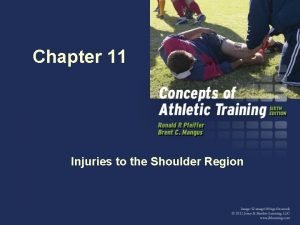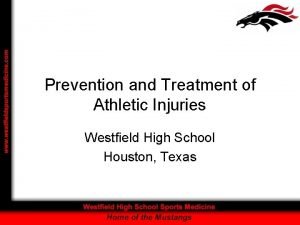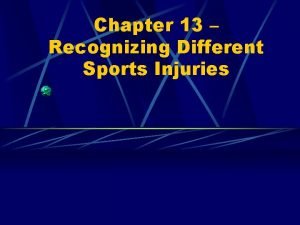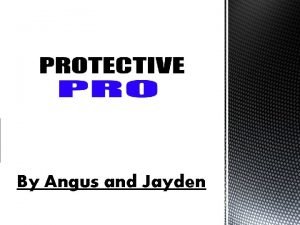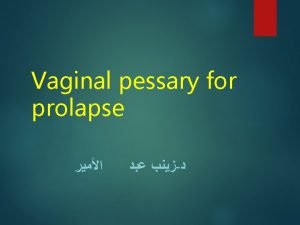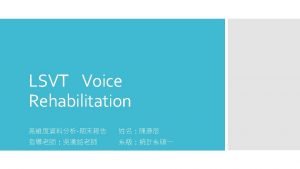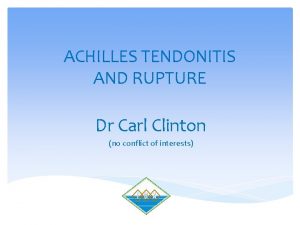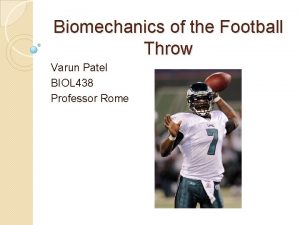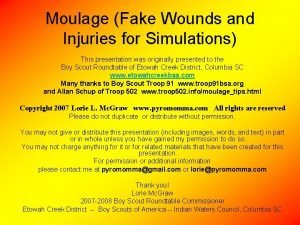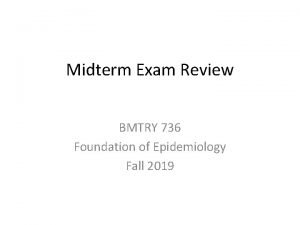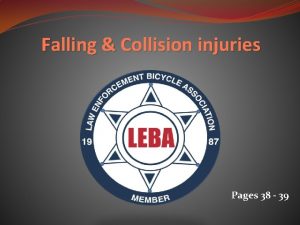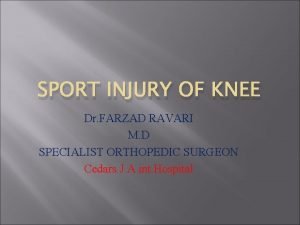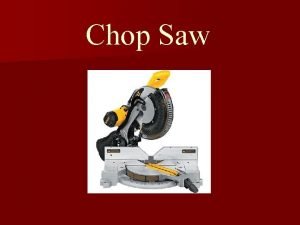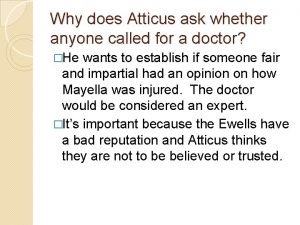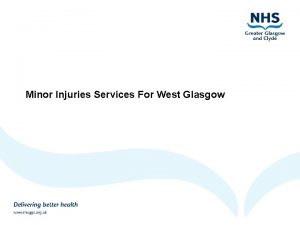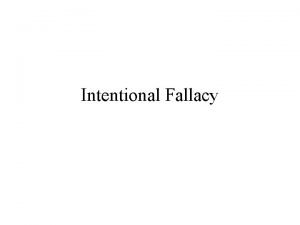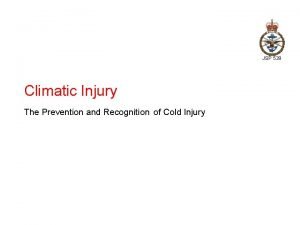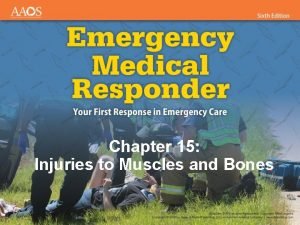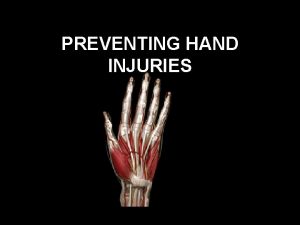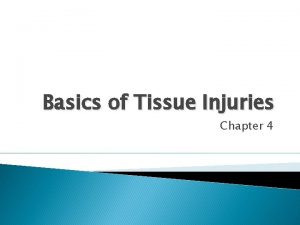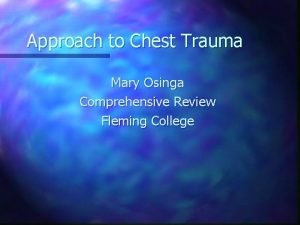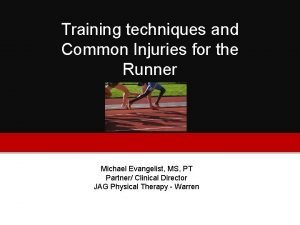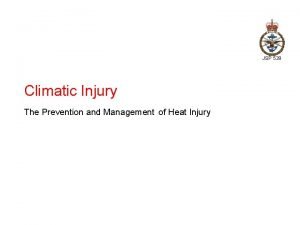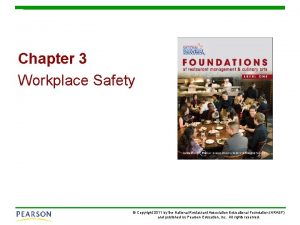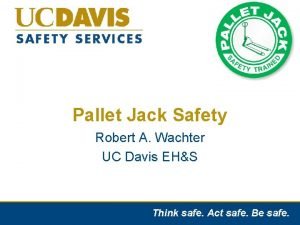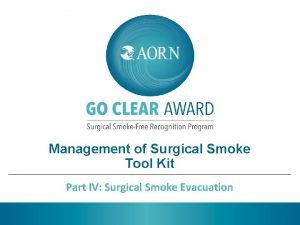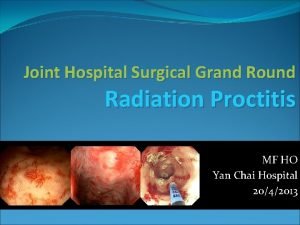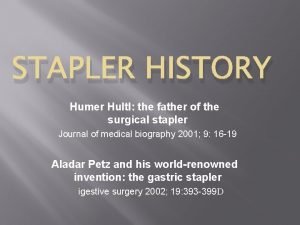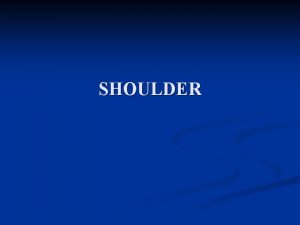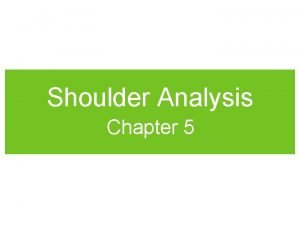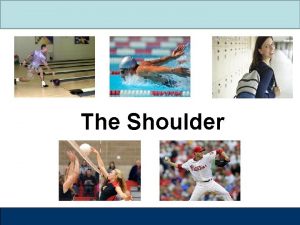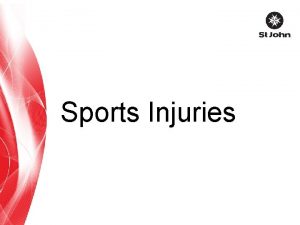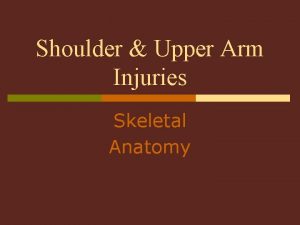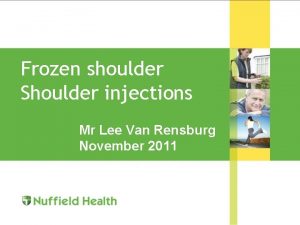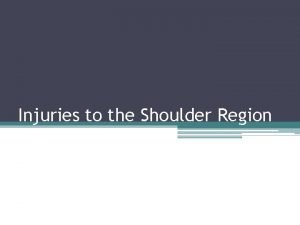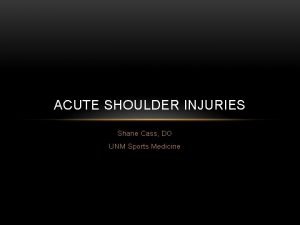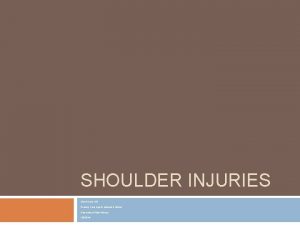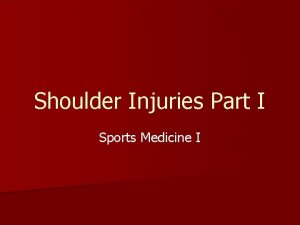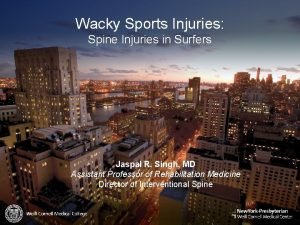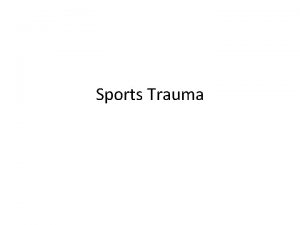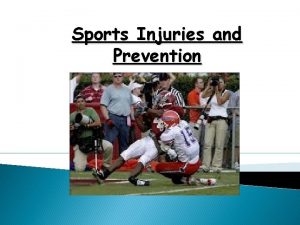Surgical treatment of shoulder sports injuries Mr Lee



















































- Slides: 51

Surgical treatment of shoulder sports injuries Mr Lee Van Rensburg United Kingdom

Objectives • Surgical options for shoulder instability – Glenohumeral • Acute traumatic • Recurrent traumatic

30 YO male, Professional Rugby payer,

Surgical options

Shoulder Instability Hippocrates 400 BC • method of reduction • cauterisation of inferior capsule

Bankart Lesion • Perthes 1906 • Bankart 1938 – “essential lesion” of the capsulolabral complex Uber operation bei habitueller schulterluxation. Perthes G. Dtsch Z Chir 1906 The pathology and treatment of recurrent dislocation of the shoulder joint. Bankart B Br J Surg 1938

Bankart Repair • Bankart 1938 • 1 st procedure 1923 on his former House Surgeon • re-attaching capsule to the glenoid with transosseous sutures • repairing subscapularis with NO overlap or shortening The pathology and treatment of recurrent dislocation of the shoulder joint. Bankart A. Br J Surg 1938

Modified Open Bankart Repair • Numerous modifications - capsular imbrication - suture anchors • Multiple series published • Accepted recurrence rate Open Bankart Repair 8 – 12% • Loss of ER

Arthroscopic Stabilisation • Johnson 1982 - Arthroscopic Staple Capsulorrhaphy - Metal Staple - 106 patients - > 18 mth F/U - 21% recurrence Early complications of acute anterior dislocation of the shoulder in middle-aged and elderly patients. Johnson JR et al. Injury 1982

Staple Capsulorrhaphy Lane et al 1993 - 54 patients Staple Capsulorrhaphy - >39 month F/U - 18 (33%) re-dislocated - 36 stable – 15 % loose staple + articular injury - < 50 loss of ER - Caution in considering Staple Capsulorrhaphy - ROM & functional level well maintained Arthroscopic staple capsulorrhaphy: A long term followup. Lane JG et al. Arthroscopy 1993

Transglenoid Stabilisation • Caspari 1988 - Transglenoid arthroscopic stabilisation - multiple sutures passed through AI capsule - transglenoid drill hole - passed A to P through glenoid - sutures tied onto infraspinatus fascia Arthroscopic reconstruction for anterior shoulder instability. Caspari. Tech Orthop 1988

Transglenoid Stabilisation • Torchia 1997 - 150 transglenoid stabilisation - F/U > 2 yrs - av age 29 yrs (14 – 67) - 11 dislocations (7. 3%) - areas of risk - P fixation - < 25 yrs Arthroscopic transglenoid multiple suture repair: 2 - 8 year results in 150 patients. Torchia et al. Arthroscopy 1997

Transglenoid Stabilisation • Soderlund 2008 - 455 army recruits (1992 – 2000) Questionaire - 312 (68. 5%) responded av 20 yr (18 -28) - Av time from surg 6. 4 yrs (1 -14) - 177 (56%) re-dislocations Long-term outcome of a transglenoid suture technique for anterior shoulder instability in young adults. Soderlund et al JBJS Br 2008

Bioabsorbable Tack Stabilisation • Bioabsorbable Tack Stabilisation Speer 1996 - 52 recurrent dislocators - Suretac stabilisation - > 2 yr F/U (24 – 60 mth) - 11 dislocations (21%) - 7 of 8 open revision Bankart healed with ‘patulous capsule’ An arthroscopic technique for anterior shoulder stabilisation of the shoulder using a bio-absorbable tack. Speer et al. J BJS Am. 1996

Arthroscopic Stabilisation • Suture Anchor Stabilisation - problems staple & transglenoid fixation - difficulty in capsule plication with tacks - improvements in suture anchor design - improvements in instrumentation

Arthroscopic washout Arthroscopic Stabilisation v Arthroscopic Lavage • 2 yr f/u (1 lavage & 3 stabilisation – lost) - Re-dislocation - stab - lavage 3/42 ( 7%) 16/42 (38%) - Reduction in risk - 76% re-disc & 82% instab Primary arthroscopic stabilisation for a first-time anterior dislocation of the shoulder. Robinson JBJS Am 2008

Suture Anchor Stabilisation • Metanalysis Hobby 2007 - 20 suture anchor stabilisation studies - 1030 patients - recurrence as end point - failure rates ranged from 0 – 30% - most < 10% Is arthroscopic surgery for chronic shoulder instability as effective as open surgery? A systematic review and metaanalysis of 62 studies including 3044 arthroscopic operations. Hobby et al. JBJS Br. 2007

Surgical options summary • Hot Poker in axilla • Open Bankart • Arthroscopic – Staple – Transglenoid suture – Suture tacks – Arthroscopic washout – Suture anchors

Again? • Age 30 continues to play what are chances it will happen again

Non-Operative Treatment Prognosis: age at time of dislocation 12 -22 yrs 23 -29 yrs 30 -40 yrs Re dislocated 73% 56% 25% x 1 disloc 20% 18% 10% no surgery 12% 10% 5% surgery 40% 28% 10% Recurrence ( > x 2) Non-operative treatment of primary anterior shoulder dislocation in patients forty years and younger. A prospective twenty-five-year followup. Hovelius et al JBJS Am 2008

Open Access Journal of Sports Medicine 2011: 2 19– 24

Diagnostic arthroscopy • Anaesthetic – GA – Regional block – www. nerveblocks. co. uk • Interscalene block • Supraclavicular +- Axillary nerve block • Setup – Beach position – Lateral position • Skin preparation – Alcohol/ chlorhexidine preparation • Propriono bacterium acnes • Prophylactic antibiotics – Implant surgery – P acnes • Flucloxacillin _+- Gentamycin

• Alcohol and chlorhexidine, superior to povidone iodine J Bone Joint Surg Am. 2009; 91: 1949 -53

Diagnostic arthroscopy • Equipment – Arthroscopy stack • 30 degree scope – Fluid management system – High flow arthroscopy trocars – Radiofrequency probe – Arthroscopic shaver – Suture passers – Anchors

Diagnostic arthroscopy • Portals – Posterior – viewing portal – Anterior- working portal (inside out, spinal needle) • Procedure – – – – – Biceps anchor Anterior labrum MGHL Subscapularis SGHL (Pulley) Biceps (tunnel) Supraspinatus Inferior recess Articular surfaces • • • Glenoid Humeral head Closure – Subcuticular prolene

Portal Placement • Anterior Portal – 2 nd 2 1 ‘working’ gleno-humeral portal

Arthroscopic Bankart

Diagnostic Arthroscopy

Suture Anchor Insertion

Knott Tying

Second Anchor

Arthroscopic stabilisation

Arthroscopic stabilisation

SLAP tears 1 Frayed 6 2 with A or P labral flap 2 Superior A and P 7 Tear into MGHL 3 2 + bucket handle 8 2 + P labrum 4 Bucket into biceps 5 Assoc dislocation 9 10 2 + Circumferential labrum 2 + P + Inf labrum

SLAP tears • Options – Debridement • Type 1 – Re attachment (SLAP repair) – Biceps tenotomy/ tenodesis

J Shoulder Elbow Surg (2011) 20, 326 -332

Again?

• Recurrence rates – Arthroscopic (suture anchor) 8 -11% – Open (Bankart) 0 -11% • Arthroscopic slightly better ROM Sports Health. 2011 Jul; 3(4): 396 -404.

Glenoid Bone Loss • Re-Dislocation - 194 arthroscopic stabilisations - 21 significant bone loss - no bone loss - inverted pear 4% recurrence 61% recurrence - “Inverted Pear” 25% of glenoid surface area Traumatic glenohumeral bone defects and their relationship to failure of arthroscopic Bankart repairs: significance of the glenoid’s “inverted pear” and the humeral “engaging Hills-Sachs lesion”. Burkhart & De Beer Arthroscopy 2000

• Glenoid • Concavity depression • De Beer – Inverted pear • Deficiency antero inferior diameter >25% – Augment glenoid • Humeral • Hills sachs lesion • Engaging Hill Sachs lesion – Dx Arthroscopy – Address humerus J Shoulder Elbow Surg (2009) 18, 317 -328

Glenoid defects • Eden Hybbinette ( 1918/ 1932) • Initially Tibia • Now iliac crest • Bristow (Helfett 1958) • 1 -2 cm Coracoid transfer distal to pectoralis minor • Single screw • Latarjet (1954) • Larger 2 -3 cm • Length ways 2 screws • Arthroscopic

Latarjet

Humeral defects • Massive Hill-Sachs lesion • >25% volume of the humeral head • Management - rotational osteotomy - hemiarthroplasty - infraspinatus transfer - osteo-articular allograft - arthroscopic remplissage

Humeral Bone Loss • Osteoarticular humeral head allograft - 18 patients failed surgery with >25% Hill-Sachs - osteoarticular allograft - 0 recurrence at 2 yrs - early x-ray evidence of allograft collapse Recurrent anterior instability following failed surgical repair: Allograft reconstruction of large humeral defects. Miniaci, Tytherleigh-Strong. JBJS 2001

Arthroscopic Remplissage • arthroscopic Bankart • capsulodesis and infraspinatus tenodesis

Summary Young sports dislocation 1 week

Bone loss - Plain x-ray - CT recon


Practically • Arthroscopic Bankart with anchors – 1 st time dislocator – Recurrent with no bony defect • Open Latarjet – Failed arthroscopic Bankart – Bony defects (glenoid) – Chronic dislocation

J Bone Joint Surg Am. 2009; 91: 966 -78

The End
 Chapter 11 injuries to the shoulder region
Chapter 11 injuries to the shoulder region Westfield sports injuries
Westfield sports injuries How are sports injuries classified and managed
How are sports injuries classified and managed Chapter 11 assessment and evaluation of sports injuries
Chapter 11 assessment and evaluation of sports injuries Chapter 13 worksheet recognizing different sports injuries
Chapter 13 worksheet recognizing different sports injuries Sports injuries angus, on
Sports injuries angus, on Vaginal pessary
Vaginal pessary Lee silverman voice treatment
Lee silverman voice treatment Now group these activity into indoor and outdoor activities
Now group these activity into indoor and outdoor activities The hunger games discussion questions for chapter 4
The hunger games discussion questions for chapter 4 Clinton achilles tendonitis
Clinton achilles tendonitis Injuries first aid
Injuries first aid Bo taoshi injuries
Bo taoshi injuries Chapter 12 lesson 2 improving your fitness
Chapter 12 lesson 2 improving your fitness Chapter 14 bleeding shock and soft tissue injuries
Chapter 14 bleeding shock and soft tissue injuries Fundamentals of throwing a football
Fundamentals of throwing a football Sentinel injuries
Sentinel injuries Glycerin and gelatin fake skin
Glycerin and gelatin fake skin The cause-specific mortality rate from roller-skating was:
The cause-specific mortality rate from roller-skating was: 17:3 providing first aid for bleeding and wounds
17:3 providing first aid for bleeding and wounds Injuries first aid
Injuries first aid Beck weathers
Beck weathers Discoid miniscus
Discoid miniscus Chapter 4 preventing injuries through fitness
Chapter 4 preventing injuries through fitness Chapter 13:2 preventing accidents and injuries
Chapter 13:2 preventing accidents and injuries Chop saw injuries
Chop saw injuries Why does atticus ask mr ewell to write his name
Why does atticus ask mr ewell to write his name Victoria hospital glasgow minor injuries
Victoria hospital glasgow minor injuries Intentional fallacy definition
Intentional fallacy definition Climatic injuries
Climatic injuries Emr chapter 15 injuries to muscles and bones
Emr chapter 15 injuries to muscles and bones Characters of firearm injuries
Characters of firearm injuries Unit 15:4 providing first aid for shock
Unit 15:4 providing first aid for shock Preventing hand injuries
Preventing hand injuries Chapter 4 basics of tissue injuries
Chapter 4 basics of tissue injuries Kristen wilson injuries
Kristen wilson injuries A short backboard or vest-style immobilization
A short backboard or vest-style immobilization Deadly dozen trauma
Deadly dozen trauma Common track and field injuries
Common track and field injuries Stretcher lift first aid
Stretcher lift first aid Injuries first aid
Injuries first aid Jsp 539
Jsp 539 Chapter 14:2 preventing accidents and injuries
Chapter 14:2 preventing accidents and injuries Which osha document summarizes occupational injuries
Which osha document summarizes occupational injuries Chapter 16 hunger games
Chapter 16 hunger games Intentional injury and unintentional injury
Intentional injury and unintentional injury Pallet jack injuries
Pallet jack injuries Chapter 21 caring for head and spine injuries
Chapter 21 caring for head and spine injuries Surgical plume evacuator tool
Surgical plume evacuator tool Diagnostic suffixes
Diagnostic suffixes Conclusion of oral medication
Conclusion of oral medication Stapler history
Stapler history
